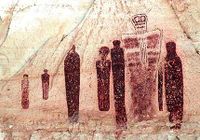Sego Canyon Cave Paintings: Difference between revisions
No edit summary |
No edit summary |
||
| Line 9: | Line 9: | ||
In 1949 a fire swept the site, drastically decreasing productions. Then when diesel engines mostly replaced coal powered steam engines the company came to a halt. After this, Sego became a ghost town.<ref>"Legends of America." (n.d.). Retrieved from https://www.legendsofamerica.com/ut-segocanyon/.</ref> | In 1949 a fire swept the site, drastically decreasing productions. Then when diesel engines mostly replaced coal powered steam engines the company came to a halt. After this, Sego became a ghost town.<ref>"Legends of America." (n.d.). Retrieved from https://www.legendsofamerica.com/ut-segocanyon/.</ref> | ||
==Fremont Tribe== | ==Fremont Tribe== | ||
From approximately 600-1250 A.D. the Sego Canyon was occupied by the Fremont Native Tribe. Named after the Fremont river and valley were most of their site were discovered, the Fremont tribe was one closely tied to nature with their hunting, gathering, and farming lifestyle. They lived in pit houses, created pottery and rock art that is distinguishable by the rectangular or trapezoidal bodies and small heads. | From approximately 600-1250 A.D. the Sego Canyon was occupied by the Fremont Native Tribe. Named after the Fremont river and valley were most of their site were discovered, the Fremont tribe was one closely tied to nature with their hunting, gathering, and farming lifestyle. They lived in pit houses, created pottery and rock art that is distinguishable by the rectangular or trapezoidal bodies and small heads.<ref>Holloway, A., (2014)."The haunting rock art of Sego Canyon – extra-terrestrials or spiritual visions?" Retrieved from https://www.ancient-origins.net/ancient-places-americas/haunting-rock-art-sego-canyon-extra-terrestrials-or-spiritual-visions-001584.</ref> | ||
==Barrier Canyon== | ==Barrier Canyon== | ||
The Barrier Canyon rock art was created by the Archaic people around 6000 B.C.-100 B.C. consisting of large manlike forms. Often these forms were missing legs or arms, had hollowed eyes, wore antennae-like earrings, and carried snakes. Figures like these may depict the ritualistic activities that took place amongst these people. | The Barrier Canyon rock art was created by the Archaic people around 6000 B.C.-100 B.C. consisting of large manlike forms. Often these forms were missing legs or arms, had hollowed eyes, wore antennae-like earrings, and carried snakes. Figures like these may depict the ritualistic activities that took place amongst these people. | ||
Revision as of 01:40, 27 November 2019
By Devon Washington

Sego Canyon Cave paintings are a group of more than 80 figures suggested to depict ancient astronauts or extraterrestrials that once visited the Earth when the multiple Native American tribes lived in this area.
Background
History of Sego
Sego Utah started off in the early 1890s as farmer Harry Ballard discovered coal on the lands next to his ranch. He then began purchasing this land to begin small scale coal mining operations that eventually rose to a small community named Ballard, after the owner. Ballard’s property was eventually bought out and the American Fuel Company began to develop the area in 1911 with plans for long-term coal production. Over time the company was plagued with water system problems, low profits, power supply issues and overall financial problems. At some points, there was no money to pay the miners, they were given scripts to spend at the company store. In 1949 a fire swept the site, drastically decreasing productions. Then when diesel engines mostly replaced coal powered steam engines the company came to a halt. After this, Sego became a ghost town.[1]
Fremont Tribe
From approximately 600-1250 A.D. the Sego Canyon was occupied by the Fremont Native Tribe. Named after the Fremont river and valley were most of their site were discovered, the Fremont tribe was one closely tied to nature with their hunting, gathering, and farming lifestyle. They lived in pit houses, created pottery and rock art that is distinguishable by the rectangular or trapezoidal bodies and small heads.[2]
Barrier Canyon
The Barrier Canyon rock art was created by the Archaic people around 6000 B.C.-100 B.C. consisting of large manlike forms. Often these forms were missing legs or arms, had hollowed eyes, wore antennae-like earrings, and carried snakes. Figures like these may depict the ritualistic activities that took place amongst these people.
Ute Tribe
From approximately 1300 A.D. –1880 A.D. the Ute Native tribe occupied the Sego Canyon area until being forced to live on reservations in 1880. The Ute tribe rock art can e identified by the horse riding figures, as horses weren’t introduced until the 16th century by the Spanish.
Pseudo-archaeological Narrative
The ancient astronaut theory attached to this site suggests that extraterrestrials visited the Earth, claiming the larger odd figures with hollowed eyes or triangular heads cannot possibly be human.
Debunking the Pseudo-archaeological Claims
Conclusion
References
- ↑ "Legends of America." (n.d.). Retrieved from https://www.legendsofamerica.com/ut-segocanyon/.
- ↑ Holloway, A., (2014)."The haunting rock art of Sego Canyon – extra-terrestrials or spiritual visions?" Retrieved from https://www.ancient-origins.net/ancient-places-americas/haunting-rock-art-sego-canyon-extra-terrestrials-or-spiritual-visions-001584.